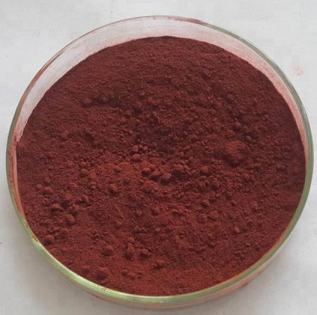|
| | Cobalt carbonyl Chemical Properties |
| Melting point | 51-52 °C | | Boiling point | 52°C | | density | 1.81 | | vapor pressure | 9.333-200Pa at 15-25℃ | | Fp | -13 °C | | storage temp. | 2-8°C | | solubility | Dichloromethane (Slightly), Methanol (Slightly) | | form | crystal | | Specific Gravity | 1.73 | | color | dark orange | | Water Solubility | Insoluble in water. Soluble in alcohol, ether and carbon disulfideSoluble in ether, naphtha and carbon disulfide. Slightly soluble in alcohol. Insoluble in water. | | Sensitive | Air Sensitive | | Hydrolytic Sensitivity | 7: reacts slowly with moisture/water | | Merck | 13,3112 | | Exposure limits | TLV-TWA: 0.1 mg/m3 as Co (ACGIH)
PEL-TWA: 0.1 mg/m3 as Co (OSHA). | | Stability: | Air sensitive | | CAS DataBase Reference | 10210-68-1(CAS DataBase Reference) | | EPA Substance Registry System | Cobalt carbonyl (10210-68-1) |
| | Cobalt carbonyl Usage And Synthesis |
| Description | Cobalt carbonyl (known as dicobalt octocarbonyl) is a versatile reagent and catalyst in organometallic chemistry and organic synthesis. It has catalytic applications in various chemical reactions such as hydroformylation of unsaturated compound, homogeneous hydrogenation of aromatic hydrocarbons, hydrosilation of alkenes, reactions of disulfides such as carbonylation to thio-esters and desulfurization to sulfides, hydroformylation as well as the conversion of alkenes into aldehydes. It can also promote both the Pauson-Khand reactions and Nicholas reaction.
 | | Reaction |
- Reagent for the Pauson-Khand conversion of an olefin, an alkyne and carbon monoxide into a cyclopentenone.
- Precatalyst in combination with triphenylphosphite for the cataytic Pauson-Khand reaction.
- Catalyzes the rearrangement of 1-alkynylcyclopropanols to cyclopentenones.
- Catalyzes the conversion of aziridines to β-lactams.
- Catalyzes the conversion of diallylanilines and aryliminies to quinolines.
- Reagent for the selective cleavage of benzyl ethers.
- Domino Nicholas and Pauson-Khand process induced by nitroarene reduction.


| | Sources | Adkins, Homer., and G. Krsek. JACS 71.9(1949):3051-3055.
Feder, Harold M., and J. Halpern. Cheminform 7.7(1976):no-no.
Seitz, Friedrich, and M. S. Wrighton. Angewandte Chemie International Edition 27.2(1988):289-291.
Antebi, Shlomo, and H. Alper. Tetrahedron Letters 16.38(1985):no-no.
Krafft, Marie E., L. V. R. Boñaga, and C. Hirosawa. Cheminform 32.37(2001):no-no.
https://en.wikipedia.org/wiki/Dicobalt_octacarbonyl
| | Chemical Properties | red-orange to dark red crystals or flakes | | Chemical Properties | Cobalt carbonyl is a pyrophoric (spontaneously flammable in air), red-orange (when pure) to dark-brown crystalline solid. | | Physical properties | Orange crystals; density 1.78 g/cm3; melts at 5l°C; decomposes above this temperature; insoluble in water; soluble in most organic solvents including alcohol, ether, carbon disulfide. | | Uses | It is used as a catalyst in many organicconversion reactions, which include hydrogenation,isomerization, hydroformylation,polymerization, and carbonylation. | | Uses | The use of dicobalt octacarbonyl as a catalyst in a variety of organic syntheses has led to the study of an extensive and important organometallic chemistry of cobalt. | | Uses | - Cobalt carbonyl [Co2(CO)8] is commonly used as a catalyst in the hydroformylation (oxo reaction) of alkenes.
- Along with pyridine, it can be used as a catalyst in the carboxylation of alkenes into corresponding acids and esters.
- It is employed as a key precursor in the preparation of cobalt platinum (CoPt3), cobalt sulfide (Co3S4) and cobalt selenide (CoSe2) nanocrystals.
- It is also used as a reagent in Pauson-Khand cyclizations and Nicholas reaction.
| | Uses | Cobalt octacarbonyl is used as a catalyst in the Oxo process. It also is used as a catalyst for hydrogenation, isomerization, hydrosilation and polymerization reactions. The compound is also a source of producing pure cobalt metal and its purified salts.
| | Preparation | Cobalt octacarbonyl is prepared by the reaction of finely divided cobalt with carbon monoxide under pressure:
2Co + 8CO → Co2(CO)8
The compound may be prepared in a similar way from cobalt(II) iodide. Also, it may be prepared by thermal decomposition of cobalt carbonyl hydride:
2HCo(CO)4 → Co2(CO)8 + H2
| | Hazard | Toxic by ingestion and inhalation. | | Health Hazard | Dicobalt octacarbonyl exhibits moderate toxicityby inhalation route and somewhatlower toxicity by intraperitoneal and oralroutes. However, it is much less toxicthan nickel tetracarbonyl or iron pentacarbonyl.A 2-hour LC50 value in mice isreported as 27 mg/m3 (Lewis 1996). Anoral LD50 value in rats is within the rangeof 750–800 mg/kg. It decomposes, evolvingtoxic carbon monoxide. | | Safety Profile | Poison by inhalation
and intraperitoneal routes. Questionable
carcinogen. Decomposes in air to form a
product that ignites spontaneously in air.
"hen heated to decomposition it emits
acrid smoke and fumes. See also
CARBONYLS and COBALT
COMPOUNDS. | | Potential Exposure | This material is used as a catalyst for a number of reactions. It is also used in antiknock gasoline and for high-purity cobalt salts. | | Shipping | UN3124 Toxic solids, self-heating, n.o.s., Hazard Class: 6.1; 6.1-Poisonous materials, 4.2-Spontaneously combustible material. Technical Name Required. UN3190 Self-heating solid, inorganic, Hazard Class: 4.2; Labels: 4.2-Spontaneously combustible material, Technical Name Required. UN1325 Flammable solid, organic, n.o.s. Hazard Class: 4.1; Labels: 4.1-Flammable solid | | Purification Methods | It forms orange-brown crystals on recrystallisation from n-hexane under a carbon monoxide atmosphere [Ojima et al. J Am Chem Soc 109 7714 1987; see also Hileman in Preparative Inorganic Reactions, Ed. Jolly, Vol 1 p 101 1987]. | | Incompatibilities | Incompatible with oxidizers (chlorates, nitrates, peroxides, permanganates, perchlorates, chlorine, bromine, fluorine, etc.); contact may cause fires or explosions. Keep away from alkaline materials, strong bases, strong acids, oxoacids, epoxides. Decomposes on exposure to air or heat (@ ~52°C) producing toxic fumes of cobalt and oxides of carbon |
| | Cobalt carbonyl Preparation Products And Raw materials |
|